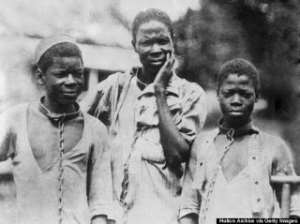
Who knows how it feels to be a slave? It's only a slave who can vividly tell someone his or her ordeal. Years after the abolition of slavery, if Africans and African-Americans, are still fruitlessly struggling to regain their lost identity, then what did their ancestors went through as slaves outside Africa, in the period of slavery?
If I look at the picture above, I see probably a mother and her two sons. The inability of the woman to help her sons has put pressure on her, taking her into a state of hopelessness, insecurity, and bewilderment.
I don't think they requested to take this image because slave owners don't listen to the cry of slaves, yet the older boy puts a little smile on his face, while the younger one shows a face of defiance, as his family becomes a subject of humiliation and ridicule.
Recorded facts about slavery are that over the period of the Atlantic Slave Trade, from approximately 1526 to 1867, about 12.5 million slaves shipped from Africa, only 10.7 million had arrived in the America and the Caribbean.
The Atlantic Slave Trade, therefore, was likely to be the most costly in human life of all of the long-distance global migrations.
On February 1, 1865, Abraham Lincoln who was then president of the United States of America, signed a resolution and outlawed slavery, since then National Freedom Day is annually observed on February 1, but years after the abolition, the scars and remnants of slavery are still haunting African-Americans or the Black man today.
They say we should forgive and forget, but certain things can't be forgotten because it's like a picture hanging on the wall. We see it every day.




 Minority will expose the beneficial owners of SML, recover funds paid to company...
Minority will expose the beneficial owners of SML, recover funds paid to company...
 Prof. Opoku-Agyemang has ‘decapitated’ the NPP’s strategies; don’t take them ser...
Prof. Opoku-Agyemang has ‘decapitated’ the NPP’s strategies; don’t take them ser...
 Abubakar Tahiru: Ghanaian environmental activist sets world record by hugging 1,...
Abubakar Tahiru: Ghanaian environmental activist sets world record by hugging 1,...
 Prof. Naana Opoku-Agyemang will serve you with dignity, courage, and integrity a...
Prof. Naana Opoku-Agyemang will serve you with dignity, courage, and integrity a...
 Rectify salary anomalies to reduce tension and possible strike action in public ...
Rectify salary anomalies to reduce tension and possible strike action in public ...
 Stop all projects and fix ‘dumsor’ — Professor Charles Marfo to Akufo-Addo
Stop all projects and fix ‘dumsor’ — Professor Charles Marfo to Akufo-Addo
 Blue and white painted schools will attract dirt shortly – Kofi Asare
Blue and white painted schools will attract dirt shortly – Kofi Asare
 I endorse cost-sharing for free SHS, we should prioritise to know who can pay - ...
I endorse cost-sharing for free SHS, we should prioritise to know who can pay - ...
 See the four arsonists who petrol-bombed Labone-based CMG
See the four arsonists who petrol-bombed Labone-based CMG
 Mahama coming back because Akufo-Addo has failed, he hasn't performed more than ...
Mahama coming back because Akufo-Addo has failed, he hasn't performed more than ...
